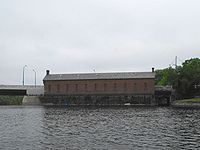
Lowell Power Canal System and Pawtucket Gatehouse
Encyclopedia
Main Article History of Lowell, Massachusetts
The Lowell Power Canal System is the largest power canal system in the United States, at 5.6 miles in length. The system's estimated output is 10,000 horsepower, operating six major canals on two levels, controlled by numerous gates. The system was begun in the 1790s, beginning its life as a transportation canal called the Pawtucket Canal
, which was constructed to get logs from New Hampshire
down the Merrimack River
to shipbuilding centers at Newburyport, Massachusetts
, bypassing the 30-plus-foot drop of the Pawtucket Falls
.
In the early 1820s, Associates of the recently-deceased Francis Cabot Lowell bought up the old Pawtucket Canal in what was then East Chelmsford, Massachusetts
. Within a few years, the new industrial center that became Lowell was using canals feeding off of a widened and deepened Pawtucket Canal as a direct power source
for their textile mills. The first of these canals was the Merrimack Canal
, which powered the Merrimack Manufacturing Company
. The repurposing of the Proprietors of Locks and Canals
allowed the Associates to sell water power to other companies, starting with the Hamilton Canal, leading to the explosive growth of the town, and then shortly thereafter, city, of Lowell.

By the late 1840s, Lowell's canal system was producing as much power as possible. However, the Chief Engineer of Locks and Canals, an Englishman by the name of James B. Francis
devised the Northern Canal and the Moody Street Feeder, to increase the capacity of, and availability of water to various parts of, the whole system. The Pawtucket Gatehouse was constructed to control flow from behind the Pawtucket Dam into the Northern Canal.
The dam itself, which was built twenty years earlier, was lengthened at that time, diverting the entire Merrimack (during periods of lower flow) into the two canal system entrances above it. It is a stone dam topped with wooden flashboards – a system still used on this dam today. The level of the water is regulated by the flashboards and the metal pins that hold them back. When there is too much water going over the top of the dam, the pins bend backwards, releasing the boards, and the outflow of the dam is increased.
The Gatehouse contains ten wooden gates that control the flow of the Merrimack into the canal. Originally, they were opened by a Francis Turbine
, also an invention of James B. Francis. Today, the Gatehouse is controlled electrically and remotely by Boott Hydroelectric, who is partially a continuation of the Proprietors of Locks and Canals, and who operates a 24-megawatt hydroplant on the Northern Canal.
The Canal System and the Gatehouse were designated a Historic Civil Engineering Landmark by the ASCE
in 1984 and a Historic Mechanical Engineering Landmark by the ASME in 1985 and are part of Lowell National Historical Park
.
History of Lowell, Massachusetts
The History of Lowell is closely tied to its location along the Pawtucket Falls of the Merrimack River, from being an important fishing ground for the Pennacook tribe to providing water power for the factories that formed the basis of the city's economy for a century...
The Lowell Power Canal System is the largest power canal system in the United States, at 5.6 miles in length. The system's estimated output is 10,000 horsepower, operating six major canals on two levels, controlled by numerous gates. The system was begun in the 1790s, beginning its life as a transportation canal called the Pawtucket Canal
Pawtucket Canal
Completed in 1796, the Pawtucket Canal was originally built as a transportation canal to circumvent the Pawtucket Falls of the Merrimack River in East Chelmsford, Massachusetts. In the early 1820s it became a major component of the Lowell power canal system...
, which was constructed to get logs from New Hampshire
New Hampshire
New Hampshire is a state in the New England region of the northeastern United States of America. The state was named after the southern English county of Hampshire. It is bordered by Massachusetts to the south, Vermont to the west, Maine and the Atlantic Ocean to the east, and the Canadian...
down the Merrimack River
Merrimack River
The Merrimack River is a river in the northeastern United States. It rises at the confluence of the Pemigewasset and Winnipesaukee rivers in Franklin, New Hampshire, flows southward into Massachusetts, and then flows northeast until it empties into the Atlantic Ocean at Newburyport...
to shipbuilding centers at Newburyport, Massachusetts
Newburyport, Massachusetts
Newburyport is a small coastal city in Essex County, Massachusetts, United States, 35 miles northeast of Boston. The population was 21,189 at the 2000 census. A historic seaport with a vibrant tourism industry, Newburyport includes part of Plum Island...
, bypassing the 30-plus-foot drop of the Pawtucket Falls
Pawtucket Falls (Massachusetts)
Pawtucket Falls is the name of a waterfall on the Merrimack River at Lowell, Massachusetts. The waterfall and rapids below it drop a total of 32 feet in a little under a mile., and was an important fishing ground for the Pennacook Indians in pre-colonial times.This location was used as a benchmark...
.
In the early 1820s, Associates of the recently-deceased Francis Cabot Lowell bought up the old Pawtucket Canal in what was then East Chelmsford, Massachusetts
Chelmsford, Massachusetts
Chelmsford is a suburban town in Middlesex County, Massachusetts in the Greater Boston area. As of the 2010 United States Census, the town's population was 33,802. The Census Bureau's 2008 population estimate for the town was 34,409, ranking it 14th in population among the 54 municipalities in...
. Within a few years, the new industrial center that became Lowell was using canals feeding off of a widened and deepened Pawtucket Canal as a direct power source
Hydropower
Hydropower, hydraulic power, hydrokinetic power or water power is power that is derived from the force or energy of falling water, which may be harnessed for useful purposes. Since ancient times, hydropower has been used for irrigation and the operation of various mechanical devices, such as...
for their textile mills. The first of these canals was the Merrimack Canal
Merrimack Canal
The Merrimack Canal is a power canal in Lowell, Massachusetts. The canal, dug in the 1820s, begins at the Pawtucket Canal just above Swamp Locks, and empties into the Merrimack River near the Boott Cotton Mills...
, which powered the Merrimack Manufacturing Company
Merrimack Manufacturing Company
The Merrimack Manufacturing Company was the first of the major textile manufacturing concerns to open in Lowell, Massachusetts, beginning operations in 1823.- History :...
. The repurposing of the Proprietors of Locks and Canals
Proprietors of Locks and Canals
The Proprietors of Locks and Canals on the Merrimack River is a limited liability corporation founded on June 27, 1792, making it one of the oldest corporations in the United States....
allowed the Associates to sell water power to other companies, starting with the Hamilton Canal, leading to the explosive growth of the town, and then shortly thereafter, city, of Lowell.

By the late 1840s, Lowell's canal system was producing as much power as possible. However, the Chief Engineer of Locks and Canals, an Englishman by the name of James B. Francis
James B. Francis
James Bicheno Francis was a British-American engineer, who invented the Francis turbine.-Early years:James Francis was born in South Leigh, near Witney, Oxfordshire in England, United Kingdom...
devised the Northern Canal and the Moody Street Feeder, to increase the capacity of, and availability of water to various parts of, the whole system. The Pawtucket Gatehouse was constructed to control flow from behind the Pawtucket Dam into the Northern Canal.
The dam itself, which was built twenty years earlier, was lengthened at that time, diverting the entire Merrimack (during periods of lower flow) into the two canal system entrances above it. It is a stone dam topped with wooden flashboards – a system still used on this dam today. The level of the water is regulated by the flashboards and the metal pins that hold them back. When there is too much water going over the top of the dam, the pins bend backwards, releasing the boards, and the outflow of the dam is increased.
The Gatehouse contains ten wooden gates that control the flow of the Merrimack into the canal. Originally, they were opened by a Francis Turbine
Francis turbine
The Francis turbine is a type of water turbine that was developed by James B. Francis in Lowell, Massachusetts. It is an inward-flow reaction turbine that combines radial and axial flow concepts....
, also an invention of James B. Francis. Today, the Gatehouse is controlled electrically and remotely by Boott Hydroelectric, who is partially a continuation of the Proprietors of Locks and Canals, and who operates a 24-megawatt hydroplant on the Northern Canal.
The Canal System and the Gatehouse were designated a Historic Civil Engineering Landmark by the ASCE
American Society of Civil Engineers
The American Society of Civil Engineers is a professional body founded in 1852 to represent members of the civil engineering profession worldwide. It is the oldest national engineering society in the United States. ASCE's vision is to have engineers positioned as global leaders who strive toward...
in 1984 and a Historic Mechanical Engineering Landmark by the ASME in 1985 and are part of Lowell National Historical Park
Lowell National Historical Park
Lowell National Historical Park is a National Historical Park of the United States located in Lowell, Massachusetts. Established in 1978 a few years after Lowell Heritage State Park, it is operated by the National Park Service and comprises a group of different sites in and around the city of...
.
Timeline of canals
- 1796: Pawtucket CanalPawtucket CanalCompleted in 1796, the Pawtucket Canal was originally built as a transportation canal to circumvent the Pawtucket Falls of the Merrimack River in East Chelmsford, Massachusetts. In the early 1820s it became a major component of the Lowell power canal system...
- 1822: Merrimack CanalMerrimack CanalThe Merrimack Canal is a power canal in Lowell, Massachusetts. The canal, dug in the 1820s, begins at the Pawtucket Canal just above Swamp Locks, and empties into the Merrimack River near the Boott Cotton Mills...
- 1825: Hamilton Canal
- 1828: Lowell Canal
- 1831: Lawrence Canal, Western Canal
- 1835: Eastern Canal
- 1847: Northern Canal, Moody Street Feeder, and Pawtucket Gatehouse

